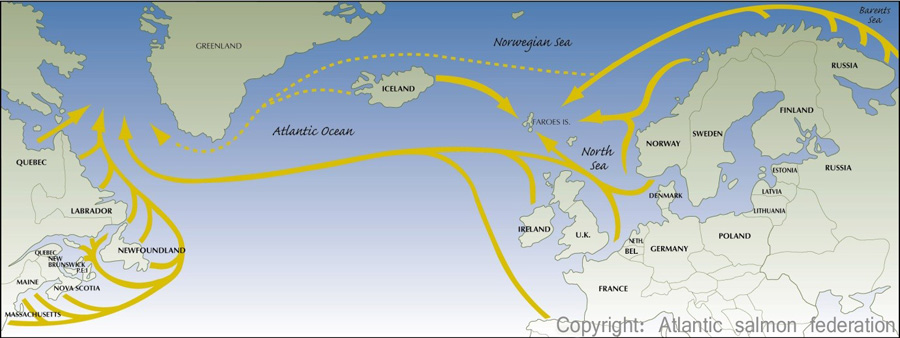Tracking Atlantic Salmon

The environmental research Institute (ERI, Scotland) at the University of the Highland and Islands is monitoring the initial movements of salmon smolts as they leave a number of rivers in the North-East of Scotland and head out to sea. The fish is tagged before they leave the river. After, a network of acoustic listening stations located in estuaries or open sea can log the individual tag number to provide a timed record of the position of individual smolts. These records will be combined with oceanographic models in the area to determine the routes taken by smolts as they move from the river to the sea on the first, critical stage of their northward journey.
The life cycle of the Atlantic salmon encompasses a juvenile feeding migration from the rivers, where they are born, to the rich feeding grounds in the North Atlantic. However, this journey is very risky and energetically very demanding. This is generally associated with numerous fish loses during the early stages of their marine migration.
Although the Atlantic salmon is among the most studied fish species in the world, almost nothing is known about the routes that smolts take in coastal waters when they leave their rivers. This information is particularly relevant as their life cycle is dependent on the completion of this marine journey. Additionally, with the arrival of marine renewables in Scotland this information is vital to inform developers about possible impacts of marine renewables on diadromous fish.
One of the main limitations in the study of salmon at sea has been the difficulties of gathering information using traditional methods (e.g. mark and recapture methods). The recent development of acoustic fish-tags has made it possible to remotely study the behaviour of smolts in the sea. The tags emit pulses of sound and automatic listening stations moored on the sea-bed are used to monitor tagged fish as they pass by. In this case, fish individuals do not need to be recaptured and the data can be accessed upon retrieval of the receivers.
Smolt tagging /salmon tracking was undertaken as part of n INTERREG /EU funded project which included assessing the migration patterns of salmon smolts in the Moray and Pentland Firths. Local information on the timing of smolt migration and the routes these fish take along the coast makes a valuable contribution to planning – particularly in relation to marine developments. Such information can inform timing around potentially harmful activities such as piling or drilling allowing these to take place outwith migration times and routes. Further studies have been undertaken since around the Berriedale and Wick Rivers. Electro fishing was used to resurvey parts of the Berridale River to find out how much the fish had grown since they were last examined; how many remained after the winter, and how large the largest fish had become. Smolt tracking from the Wick River combined with oceanographic models in the area, has been used to determine the routes taken by smolts as they move from the river to the sea on the first, critical stage of their northward journey.
Key contact - Jason McIlvenny